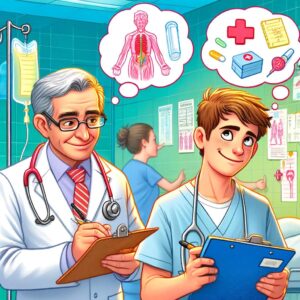
Every year, our editors at Gurufi help scores of candidates earn admission to their dream medical school. In the fifteen years I have been helping applicants, I have noticed that far too many applicants don’t put enough time or thought into their Work & Activities sections.
Crafting the Work & Activities (W&A) section of your AMCAS (American Medical College Application Service) application is a crucial task that requires careful thought and precision. Unfortunately, while many people spend weeks or ever months fine-tuning their personal statement, they treat this vital section almost as an afterthought. The W&A section allows you to showcase your experiences, learning, and growth in a succinct yet comprehensive manner and provides the reader with a clear overview of your overall strengths as a candidate. Here are some essential tips to help you make the most of this opportunity.
Focus on Your Actions, Learning, and Growth
When describing your experiences, it’s important to clearly articulate what you did, what you learned, and how you grew from each activity. Admissions committees are looking for evidence of your dedication, skills, and personal development. Applicants will sometimes get this wrong by spending too much time describing what the organization does or talking too much about things that don’t relate directly to their roles or tasks.
What You Did: Describe your specific responsibilities and actions. For instance, if you volunteered at a clinic, detail the tasks you handled, such as assisting with patient intake or organizing health education workshops.
What You Learned: Reflect on the skills and knowledge you gained. Did you develop better communication skills, learn about healthcare disparities, or gain insight into patient care?
How You Grew: Explain how these experiences influenced your personal and professional growth. Did they strengthen your commitment to medicine, enhance your empathy, or inspire you to pursue a particular medical specialty? If you struggle to nail this down, think about who you were before you started and who you were afterward. How are these different people?
Highlight Promotions and Expanded Responsibilities
If you received promotions or were given additional responsibilities, make sure to mention these. They demonstrate your competence, reliability, and the trust others have placed in you. For example, if you started as a volunteer and later became a team leader, highlight this progression to show your leadership and ability to take on more significant roles.
Avoid Jargon
Medical and scientific jargon can be confusing and may not convey your experiences effectively. Moreover, individual organizations often use idiosyncratic title names or other descriptors that don’t mean anything to people outside the organization. Use clear and straightforward language to ensure your descriptions are easily understood by all readers. Instead of using technical terms, explain your activities in a way that highlights your contributions and impact and think about how you might describe what you did to a loved one who isn’t in the medical world.
Choose Strong Verbs
The verbs you use can significantly influence how your actions are perceived. Strong, active verbs convey confidence and decisiveness. For example, instead of saying you “helped with patient care,” say you “provided patient care” or “coordinated patient services.” This subtle change makes your role sound more impactful and direct.
Be Succinct but Complete
You have only 700 characters for each entry, so brevity is essential. However, being succinct doesn’t mean using incomplete sentences or resorting to “CV speak.” Write in complete sentences to ensure clarity and coherence. Focus on the most critical aspects of each experience and eliminate any unnecessary details.
Plan Your “Most Significant” Experiences Thoughtfully
Deciding which experiences to designate as “most significant” should be done in conjunction with planning your personal statement. Because you get an extra 1325 characters, you can obviously cover a lot more ground, which is a huge benefit. Taking a strategic approach ensures you provide comprehensive coverage of your strengths and avoid redundancy. Your personal statement will delve deeply into your motivations and key experiences, while the Work & Activities section can highlight a broader range of accomplishments.
Review Last Year’s Secondary Essays
Looking at the secondary essay prompts from the schools you’re applying to can provide valuable insights. Most schools reuse essay topics for multiple years before changing, so understanding what they’ve asked in the past can help you align your “most significant” selections with potential secondary essay themes. This foresight can save you time and ensure your application remains focused and relevant.
Emphasize Breadth in Your Work & Activities
While your personal statement focuses on the depth of your decision to pursue medicine, the Work & Activities section should emphasize breadth. This is your chance to demonstrate the variety of your experiences and how they collectively prepare you for a career in medicine. Highlight diverse activities such as clinical work, research, volunteering, leadership roles, and extracurricular pursuits to present a well-rounded picture of your qualifications.
Apply the Same Care as Your Personal Statement
The Work & Activities section is just as important as your personal statement, so it deserves the same level of care and attention. Meticulously proofread your entries, ensuring they are free of errors and clearly communicate your achievements. A well-crafted Work & Activities section can significantly enhance your application and leave a lasting impression on admissions committees.
Example Entry
Here is an example of how to succinctly and effectively describe an experience:
Volunteer at Community Health Clinic (June 2020 – Present): Coordinated patient intake, assisted with health screenings, and organized educational workshops on nutrition and wellness. Developed strong communication skills and a deep understanding of healthcare disparities. Promoted to team leader, overseeing a group of 10 volunteers and managing clinic operations during weekend shifts.
This entry clearly outlines the responsibilities, learning outcomes, and growth experienced, all within the character limit. Note that the above provides a 388-character breakdown of the job. From there, you could add another 312 characters where you could briefly mention something like the most important task you accomplished, how this informs your thoughts on medical school, where this fits within your journey to medicine, or where you hope to go from here.
Conclusion
Writing the Work & Activities section of your AMCAS application requires careful planning and thoughtful execution. By focusing on your actions, learning, and growth, using clear language and strong verbs, and strategically selecting your most significant experiences, you can create a compelling and comprehensive account of your qualifications. Remember, this section is a vital component of your application, so give it the attention it deserves to ensure you stand out in the competitive field of medical school admissions.
Our editors at Gurufi have years of experience helping people put together their W&A sections. You can check us out here if you need help revising them, including making them fit within the tight character caps!

